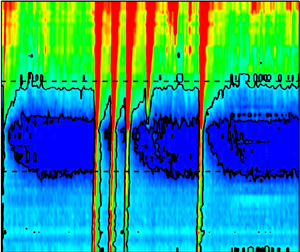Article contents
Turbulent spot transit of a hypersonic laminar separation
Published online by Cambridge University Press: 31 January 2022
Abstract

This paper presents an experimental study of the interaction of turbulent spots with an initially laminar separation, using schlieren visualisation and dynamic measurements of surface heat transfer and pressure. The separation is generated on a blunt cylinder-flare body, tested at Mach 9, and entropy layer effects result in a boundary layer edge Mach number of 3.43 at separation. A single roughness element is used to produce isolated spots, defined such that separation collapse and re-establishment is completed before arrival of the next spot. On average the spot axial length, at the start of the interaction, is 2.5 times the separation length, growing to 6.8 times as the spot base passes the original reattachment position. As such the spot comprises a large perturbation. The local separation responds almost immediately with passage of the spot, so that the downstream region may be unaffected while the upstream part has already collapsed. Re-establishment of separation is slow, taking up to four times the total transit time of the spot. A basic model is presented to explore the transient wave processes during spot passage.
- Type
- JFM Papers
- Information
- Copyright
- © The Author(s), 2022. Published by Cambridge University Press
References
REFERENCES
- 1
- Cited by





